Introduction
Business organisations of today are continually facing challenges for the progress of their business. The ultimate goal of modern organisation is to maximise its shareholders equity. To do this, organisations are simultaneously changing their strategies, production as well as delivery process. Business in all sense becomes more competitive and complex. To get advantages in this competitive world organisations are taking help of different tools and theories. Team Learning is one of the widely cultured practices of modern corporate world.
Team learning means the skill to give proper solutions to different types of problems arising in business trough grouping of people. In an organisation, there are different types of people having different types of skills, knowledge and experience. By grouping people of different skills and knowledge brings the chance to share this skills and knowledge within different employees. It has been proved that team learning helps an organisation to get competitive advantages and much other recompense. Royal Mail Holdings plc is one of the examples of these.
Theoretical Dilemma of Team Learning
What is team?
Triad consulting, (2004), mentioned that team is a set of small number of people, who has gathered together to comment, discuss, implement and recommend on some clear and identifiable goals and accountable to get those goals completely. Organisation establishes various teams to simplify its work and to get competitive advantages. There are different types of teams. These are:
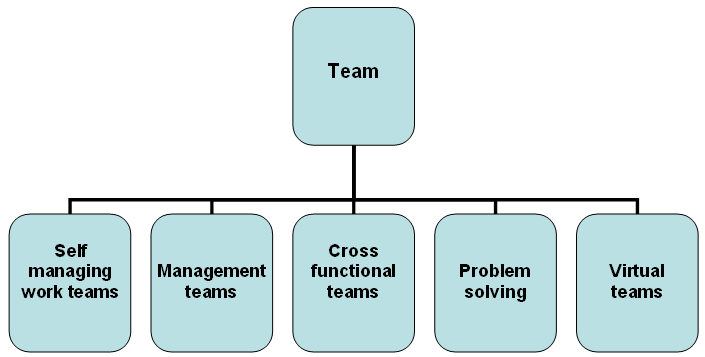
Hartenian L. S., (2003), argued that the benefits of teams are widespread in both terms of giving the organisation a competitive advantage as well as members’ personal gain. For the organisation, team is useful in many ways. These are:
- Improvement of the productivity of the firm.
- Increasing the creativity of the members.
- Decrease the time to response of the members.
- Development in decision making.
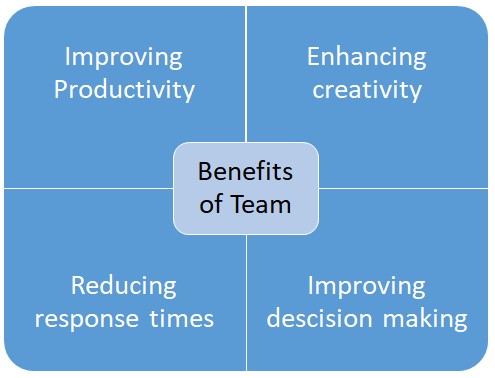
What is Organisational learning?
Senge M. P., (2009), explained that in an organisation has to take some decision mainly depending on the members involved in the decision making process and the knowledge and capabilities of the team members. Organisational learning is the way to imply the knowledge of the members in decision-making process. Learning Organisation stands for the Organisation, which continuously is increasing its capability to build its strong promises to do better in future. Learning Organisation is one, where-
- Continuous expansion of true desired result oriented capability of the members are happened,
- Culturing off innovative and extensive methods of thinking are being done,
- Make the collective ambition free,
- The teaching of how to learn collectively is done continuously.
Senge M. P., (2009), also said that there are five criteria to be an effective learning Organisation. These are:

The three major causes for thinking team learning an important task are:
- Increase the adaptability of the Organisation to take the changes positively.
- Failure of management to enhance strategic planning, describes the suitability of team learning.
- Decrease in paradigm blindness plaguing of the organisation.
Chan C.A.C., et al (2003), stated that the modern organisations are becoming learning organisation with an avoiding strategy of threats and vulnerabilities. It has been qualified by different studies and researches that the organisational learning or becoming learning organisation is completely dependable on the collective learning of the employees of that organisation. Another assumption is that to compete properly in the current competitive market, is more or less dependence in the inter relationship between the learning process of the individual as well as teams and organisation level. An important view towards the organisational learning is that, the success of organisational learning is not the individuals who learn through the team learning process but the effectiveness and advantages of the process of learning. Thus, team learning is linked with organisational learning.
What is team learning?
Team learning is a way to learn something in a group of small numbers of people. Bang, T. Y. (2008) mentioned that it is a multiple process of conjunctive and mutually dependent activities, which are done through experiment, insightful communication and knowledge codification. Bang, T. Y. (2008) also argued that in these processes of tem learning, the members of the team get and share extraordinary knowledge and information and test what is useful and what is harmful for the collective performance. Teams are now being given autonomous power and authority. Chan C.A.C., et al (2003), said that the reason is that, team learning gives the ability to cultivate numerous numbers of knowledge, innovative ideas, experiences and communication media, as because competitive advantage is a key outcome of team learning, it is getting more importance day by day.
In other words, it can be said that, capture, retention, recall and application- these four things are associations of the learning. Yazici H. J., (2005), argued that inter linked behavioural activities are build the Organisational learning process. Idea invention, communication proficiency, decision making and act as per the decision are the key activities.
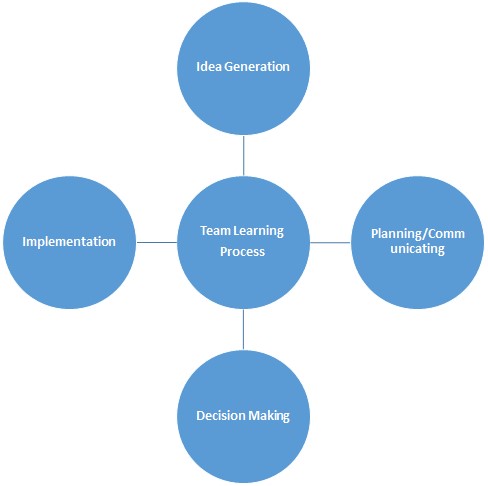
By doing these, the members of the teams can identify the mistakes and can also get the opportunity to correct them. Chan C.A.C., et al (2003), stated that when a group of people identify and correct their mistakes continuously, at one time, it results almost zero mistake and as a result, the improvement of efficiency and the betterment of the product quality occurs. Team learning gives the collective experience of attaining a goal, which will help the members in future.
Types of team learning:
- External team learning: Looking for new information and demanding feedback is the two most important actions, which members of team may act. Honold, L., (2006), argued that external team learning is the extent to which the management and the customers of the team measure the frequency of the members of the team involved in these acts.
- Internal Team Learning: Measurements of effectiveness is done by the team members by examine their performance against standards. Along with these, team members may involve with some other actions, such as- attaining new information, assumptions testing and introduce new opportunities. Internal team learning is learning lessons or experience activities regarding these actions of the team members.
Chan C.A.C., et al (2003), mentioned that the attitude of team learning behaviour are summation of some activities consisting- inquiry or question asking, giving according feedback, investigate information, consulting errors, doing experiments and examining the outcomes.
Comparison of different theories
The two theories are different in the sense that the first one keeps importance on the individual efficiency and knowledge. It does not emphasise on the advantages of the organisation. It fails to mention the way to achieve the goals of the organisation. Efficiency and knowledge of individuals do not bring any advantages for the organisation. But the second theory sets the ultimate goal is to achieve the advantages for the organisation. It emphasise innovativeness, positive attitudes to share knowledge and skills to achieve the goal of the organisation.
The limitation of these theories is, both the theories states team learning as an important factor, but fails to create a linkage between the team performance and the ultimate goals of the Organisations. But in the new theory, it has been clearly stated that, team learning is important for getting the organisational goals and individual learning is essential for team learning. When an individual learns, he would communicate the experience and share the knowledge to the other members of the team. The other members of the team will learn the matter and implement the knowledge to attain the organisational goals.
Belbin’s Team Role theory
In 1981, Belbin has been recognized eight team roles, which were modified and amplified in 1993 to nine roles that help an organisation to manage its activities with high aspirations and he recommended that management team of six persons was perfect for operational on difficult troubles. As a result, one team member has to take the responsibility of more than one sector among nine team roles. In the following figure has described the type of team role, their contribution and allowable weaknesses, which assists to understand the Belbin’s team role theory.
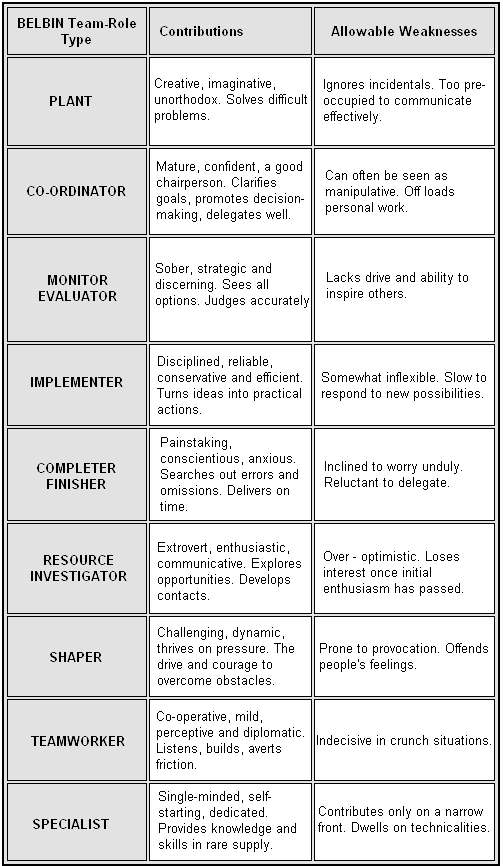
However, many of the UK companies have broadly adopted this team role theory in both training department and team expansion and the evidence shows that it influenced the team performance. Chong, E., (2007), argued that the Belbin’s team role theory has maintained that high performing teams require to have all nine roles which have balanced naturally. The following diagram of the inspection of Belbin’s theory is describes both positive and negative side of high performing teams and from here it will be possible to identify, how the team members were managed their time efficiently functioning within their own remit. These types of team can successfully continue their activities under high pressure because before taking any decision they discuss the problem, and then fix their planning. From the above discussion, it can be said that the Belbin’s team role theory is effective for organisation.
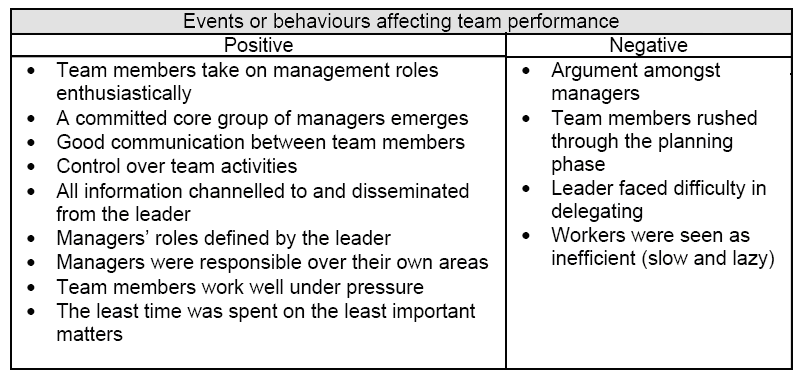
Manager’s role in Team learning
Bang, T. Y. (2008) stated that there are both a positive and negative relation between the managers and the teams. In the largest part of managers would try to stir up the formation and course of action of the team. However, in some cases some managers do not consider that teams are essential for the learning and improvement a process. There exists another dilemma where some of the managers oversimplify the tasks of the team as well as assume that teams should be independent. Nevertheless, the foremost fact is that, without the help of the manager, team learning cannot be more effective.
Phillips, J. J. & Phillips, P. P. (2003) mentioned that manager’s contribution in learning and progress is a continuous process. There are many opportunities are present for manager’s to be involved in the learning as well as enlargement process because there are too many steps within the model of team learning. Within the process, manager’s input and active contribution usually occurs in the major state of affairs. Manages would involve themselves in most of the key points of the team learning and department.
Phillips, J. J. & Phillips, P. P. (2003) also addressed the manager’s role in team learning in the points as
- Coordination of team learning.
- Participate in requirements of assessment.
- Train the employees.
- Serve as area experts.
- Strengthen learning.
- Weigh up learning application and impact.
Thus to achieve the ultimate goal of team it is important to identify the role of managers in the team learning whether it would be a role of simple manager or role of leader even the role of between the three roles so that you will know when to use the appropriate role of facilitator.
Scope of the study
As because team learning is an important strategy to achieve the organisational goal, this study would facilitate the organisations to understand the necessity of team learning. This study will help different organisations to determine how they can entail team learning within their organisation. This study also demonstrates the sophisticated and effective way to get improved outcomes by introducing team learning within their organisation. It also provided the proper evidence of the usefulness of the effective use in organisation- The Royal Mail. As because, the study has a significant part concerning on the royal Mail, Royal Mail can also get benefit from this report.
Literature to Establishing of New theory
Srikantia, P., and Pasmore, W., (1996) stated that the doubt and conviction are two stages of team learning where the doubt concerned with the effectiveness of the course of action of the organisation is the primary step of learning. The subsequently stage is conviction. Confusion and doubt embark on the learning process where conviction carries on the process by accommodating active carrying out tests. Both of the two are psychological states of interior effort. The magnitude of doubt is illustrates that the identifier of the correspondence among the individual learning and group conviction. Srikantia, P., and Pasmore, W., (1996) proposed this is a cycle about as-
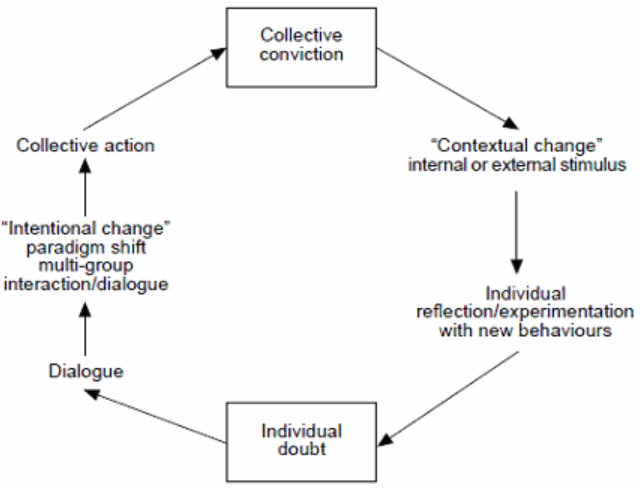
Yeo, R. (2002) explained that the organisational learning as a three dimensional sword. These three-dimensional are as flexible systems, shared vision and team dynamics. The role of leadership here is as a significant enabler. Their observation is that the learning carries system development with strategic goals designs. The learning and conversation with expression is the results of an assortment of facets of learning.
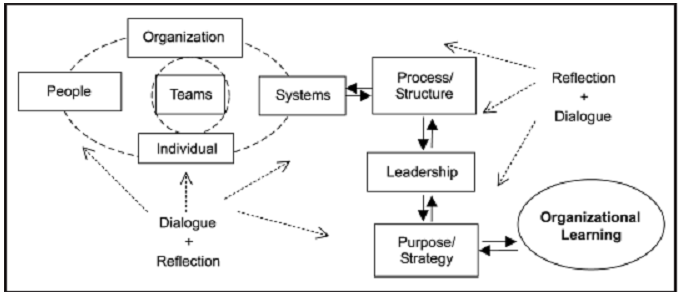
Yeo, R. (2002) presented the above the above graph aimed to interactions of shared views inside the teams including open and easier operating systems as well as quality and ability of the teams provide the learning that brings restitution and alteration in the behaviour, environment, quality and productivity of the organisation. An integrated framework of organizational learning has been proposed here:
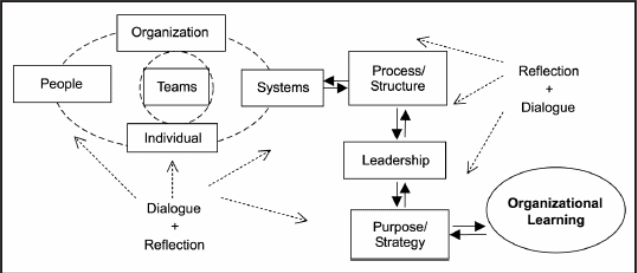
Through reflection and dialogue individual gather a vision and shared with other people of the teams and other teams. Thus, organisation confronts this vision and makes changes to the system. Again, the dialogue and reflection designs the process, influence the leadership and enables strategy. The result is the organizational learning. From the Annual report-2008, the capability of handling mails is in good number. However, it can be more if royal mails implement this theory.
Ortenblad, A. (2001) argued that the organisational learning and learning organisation as two different things. He states organisational learning as an implemented systems and learning organisation as a type of organisation. Existing three distinctions are:
- In organisational learning processes and structures is “Character of the content”, where in a learning organisation it is the form of the organisation.
- In organisational learning “Amount of normatively” can be of descriptive but in a learning organisation it is normative.
- “Group of target” is academics in case of organisational learning but it is the practitioners and consultants in a learning organisation.
There are two complementary dimensions: entities of learning and existence of knowledge. By entities of learning all the individual, the organisation and the teams are termed. By knowledge location Inner and outer aesthetics of individuals and the resulting knowledge are indicated.
Chan, C. C. A., Pearson, C., and Entrekin, L. (2003) examined the effect of tem learning on team performance with evidence of Australian hospital and concluded that both external and internal team learning enhanced performance within the groups. Barker, M. and Neailey, K., (1999) shaped a 4 stage team learning style as follows-

Where the key purposes of these four stages presented as-
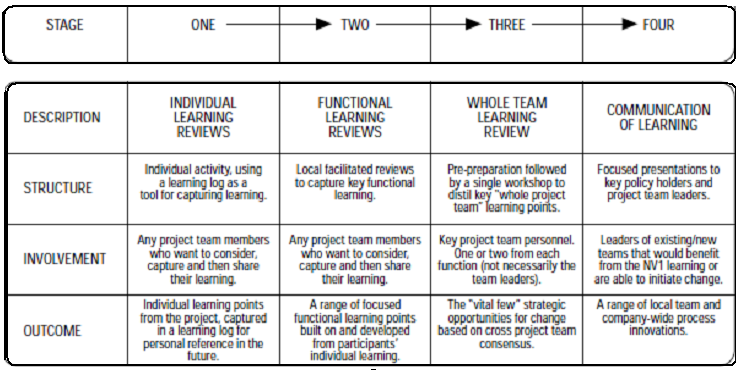
This theory entails that the failure of context of providing the lack of weightiness to plan to take into care of team learning and restrictedness of the procedure of learning appraisal the hold back team of learning. It also taken into account a few numbers of total innovations are the key characteristic to measuring the success. There are some significant contributors for the success. First of all, it makes the process out of the predisposition to be fashionable but not to making inclusive. It point toward the convivial propensity of anyone who wishes to contribute.
Barker, M. and Neailey, K., (1999) has presented the comparison among team and individual learning. They argued that the team learning is dependent relative to a position of individual learning to underneath the individual with key issue. It involves the oppressiveness of innovative thinking encouraging diverse categories ideas.
Sun, Y. T. P., & Scott L. J., (2005) mentioned the rising of blockades of knowledge relocation at various levels of the organisation with Delphi technique designed. The course of action of knowledge formation has anticipated through the illumination and move of the supported theory. Various questions on the subject of the organisational culture may create blockade to knowledge transfer. There are four stages of organisational knowledge transformation method where each of these levels with own variety.
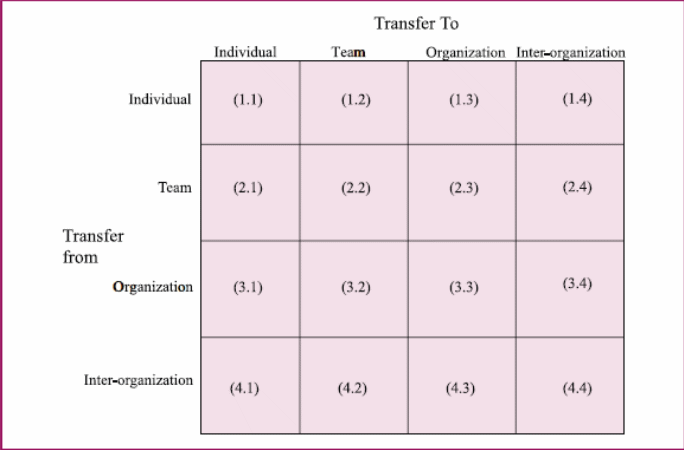
In the other way, Delphi technique is designed to find the barriers of knowledge transfer. There are two stages in this technique. First stage is designed to eliminate the barriers with the help of information transfer between the various levels of the organisation. The second stage is designed to determine in how effectively and efficiently these sources of barriers. The key effects of sources of barriers are:
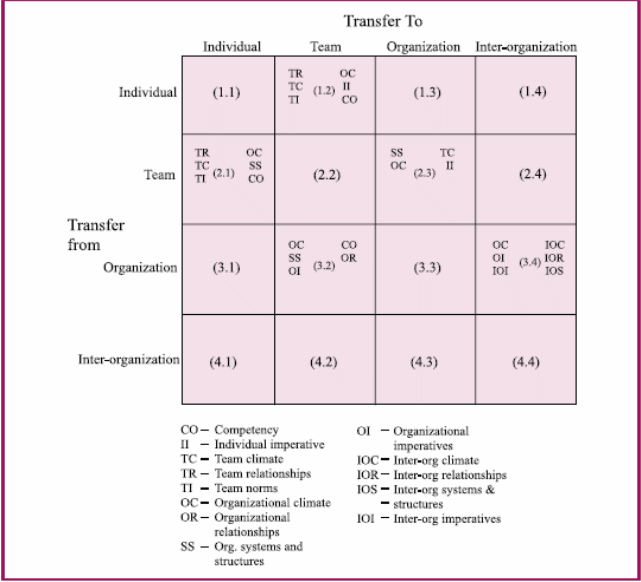
The results of these investigations show the impact of sources of barriers in different levels of learning in the organization. Sun, Y. T. P., & Scott L. J., (2005) also argued that the sources of barriers imitative, functional at all levels of learning in the organisation provide a precious parameter to practitioners. This study has left out ways of shift that are not considered primary And left these as upcoming factors of study.
Royal mail can use this theory to investigate the barriers of their operation. If these barriers can be identified, the efficiency of work and the high service quality will be increased.
Hong, J. (1999) states that the academies and various practices of organisational learning, formation of knowledge and management became buzzing words since 1991, which is extremely a great deal of significant for knowing competitive advantages of the organisation. For better sympathetic concerning organisational learning, the awareness regarding information-processing capacity has gathered.

Hong, J. (1999) added that the organisational learning also could be gathered by change of insight, modern structure of organisation, and current actions of the experiences of problematic situation of individuals in an organisation. The outcome of organisational learning can be benefited the organisation by:
- Well- built concept of Economic disciplines.
- Measurement of manufacturing cost reductions.
- Increasing production volume.
- Gaining efficiency in work and external environment.
Kiedrowski (2006), the improvement and changes in organisations are always unpredictable, uncertain, and turbulent business conditions with comparing the source of competitive advantages. The absence of organisational learning can create absent capability and disposition in measurement of progress in learning organisation and organisational performances.
Loo R., and Thorpe K., (2002) has developed a study of reflective learning, where teamwork is difficult for conflicts between members and leader of the team. It can be managed partially by training, communicating between team and leader’s skills.
According to this theory, the first stage is creation of awareness. This means consciousness about the positive attitude towards different learning situation. The next stage is critical thinking. Here individuals analyse the present condition and make clear perceptions about it. They evaluate and examine the situation and correlated it with their growing self-awareness. The final stage is the outcomes of the two stages, which is the Learning.
Loewen and Loo developed a study with some disciplines, where they talked about main supporter in learning organisations. Another restrain, they also talked about are personal mastery and third one is ability to recover internal view of world by mental model, fourth discipline is developed as team learning, last and fifth one is acquisition of learning in individual and group levels. This process is done by sharing, generating, evaluating, and combining members’ knowledge. There are mainly nine types of learning in any organisation:

The individual and team learning tools are used in critical process of learning, for understand and improve their learning. There are some actions taken for teams to determine meaning, reflect actions in determination of reflect and future actions based upon those actions.
New theory based on old theories
There are many theories regarding the team learning process. Two of them are widely popular and mostly exercised in different conditions. These are:
- Three schools of thought learning theory.
- Learning organisation theory.
Three schools of learning Theory:
This theory was developed through 1978 to 1996. The theory was reformed by Kolodny, Argyris, Schon, Senge and Mumford in different times. The theory states that, an organisation can get competitive advantages through the individual learning of the employees of the organisation. Jennet, B. (2001) also said that to become a learning organisation, individual learning is essential to apply.
Learning organisation theory:” The fifth discipline”
This theory is being given by Peter Senge, who at first introduced the term “Learning organisation” in his book “The fifth discipline”.
According to Senge M. P., (2009), the theory states that the procedure of team learning is the way of aligning and increasing the capability to make the truly desired outcomes. It means equality among the skills and the efforts of all the employees. Different employees have different talents and skills but shared vision equals their knowledge. Another important notion of this theory is that, Teams create smooth path for getting competitive advantages and team learning brings higher productivity than individual learning.
Based on these two theories, a new notion can be introduced. The key point is that, Team learning is able to give greater opportunities in the competitive marketplace by sharing experiences and visions among the members of the group. But the team learning will not be attaining without individual learning. That is, individual learning confirms a member of the team to work properly within a team and through team learning, teams confirm the competitive advantages to the organisation.
Critical review
Team learning is essential for an organisation not only in the sense of attaining competitive advantages but also for the betterment of the employees. Margerison, C., (2001), said that there are nine key competencies of tem learning and these are-
- Advising: A team can advise the organisation by attaining and submitting various types of information.
- Innovating: By generating new ideas, a team can be helpful for the organisation.
- Promoting: Identification and reporting of potential opportunities are done by the teams.
- Developing: After designing new ideas, assessing and testing of these processes are also done by the teams.
- Organizing: Cultivating the ways to do a work is also a key work for the teams.
- Producing: Production of an organisation has also done by the teams. Delivery of the products is also done by different teams.
- Inspecting: Teams do the work of monitoring and auditing of the systems.
- Maintaining: Matching the standards of the product with previously established standards is a key work of the team. Teams help the organisation by safeguarding of these standards and procedure of production.
- Linking: Communicating and coordinating between the external and internal people is also done by the Organisation’s teams.
From the above discussion of team learning it can be said that, Team learning has positive impact not only to the organisation, but also to the members of the Teams. Team learning is the summation of all the processes to learn through a collective nature and share the Knowledge, experience, by which members of the teams can realize their mistakes and take initiatives to resolve that mistakes. By resolving these mistakes, they are directed towards the achievement of the goals of the Organisation.
Recommendation
Royal Mail Holdings is doing better business now. But their business can be much better. As because the volume of their total service is decreasing, some initiatives should be taken by Royal Mail. It can start communicate their uniqueness and the advantages of traditional mailing activities. Through different advertising media, it can make aware its customers. Team learning can be helpful for this also. Members who learn through team learning will help to design the advertising more efficiently and effectively.
Team learning is dependant on individual learning, and to become a learning organisation, team learning is an essential tool. So, it can be said that- the notion of the described two theories should be replaced by the new one, which is nothing, but the aggregation of these two theories. The mail goal of this theory is to emphasise equally on the personal benefit of the employees and the betterment of the organisation through achieving its goals. Royal mail can also implement this theory in workplace.
The limitations of Team Learning
Team based learning has some limitations as well. In almost al organisation, the effectiveness of the team-based learning is dependant on the internal environment of the organisation. The major limitations of team learning are:
- Possibility of arise of conflict: In a team, various types of people with different values and different origin are gathered together. For this, there may create a conflicting situation while working. Different person has different points of view, thus, their opinion may conflict with is other. This conflict may hamper the working condition of the organization.
- Excess competition: While working in an organisation, people may practice unnecessary completion. This is harmful rather helpful for the productivity of the person. The result of these unnecessary competitions is the waste of valuable productive time.
- Time-consuming practice: The creation, training, giving lessons and work as per lesson consumes a huge amount of time. To gather members and test their affinity and potentiality takes time. This time can limits the total production time and in some case increases the total production time.
- Monetary drawbacks: Establishment of teams need additional money and thus may create pressure on the investment and production capacity of the organisation. Maintaining the team and arranging learning session may be cost a good amount. It is totally impossible to calculate the cost and the benefits of this team learning.
Conclusion
Various types of teams are using to improve communication between employees. Teams are also being used to solve business related problems. Hartenian L. S., (2003), stated that the ultimate goal to use teams is to improve productivity. Royal mail is one of the best examples of beneficiaries of team learning. Different theories of team learning have been integrated to bring the highest outcome of team learning. As a matter of fact, that the world is changing continuously, the market is becoming more, and more complex, new theories are thus needful for the present corporate world.
Bibliography
Bang, T. Y. (2008) An Exploratory Study of the Team Learning Typology Based on Environmental Fit. Contemporary Management Research. Web.
Barker, M. and Neailey, K., (1999), From Individual Learning to Project Team Learning and Innovation: A Structured Approach. Web.
Briner W., (2001), Team and Organisational learning in a cross-functional community of practice: the importance of privileging voices. Web.
Clutterbuck D., (2003). Teams and learning: the agenda has changed: Does an over-concentration on task drive out learning? Web.
Chan C.A.C., Pearson, C., and Entrekin L., (2003). Examining the effects of internal and external team learning on team performance. Web.
Hong, J. (1999), Structuring for organisational learning, The Learning Organisation Volume-6, Number-4 pp. 173-185. Web.
Hoffman J R., and Rogelberg, S.G., (1996). A guide to team incentive systems. Web.
Honold, L., (2006), Reflective Notes: a tool for individual and team learning. Web.
Hartenian L. S., (2003). Team member acquisition of team knowledge, skills, and abilities. Web.
Jackson C J., (2001). Predicting team performance from a learning process model.
Jennet, B. (2001) The relationship between team and organisational learning. Web.
Loo R., and Thorpe K., (2002), Using reflective learning journals to improve individual and team performance. Web.
Loewen, P., & a Loo, R., (2004) Assessing team climate by qualitative and quantitative approaches Building the learning organisation. Web.
Margerison, C., (2001). Team Competencies. Web.
Ortenblad, A., (2001). On differences between organisational learning and learning organisation. Web.
Phillips, J. J. and Phillips, P. P. (2003). Required Course: Manager’s Role in Learning and Performance, ROI Institute, Inc. Web.
Ross T. M., Jones E c., & Adams S. G., (2008), Can team effectiveness be predicted? Web.
Royal Mail Group Plc (2008), Regulatory Financial Statements 2007, Part 1: Audited financial information. Web.
Royal Mail Group Plc (2008), Regulatory Financial Statements 2007, audited financial information. Web.
Royal Mail Holdings plc (2008), Royal Mail Holdings plc Report and Accounts Year ended 2008. Web.
Royal Mail Holdings plc (2008), Trading update for the half year ended 2008. Web.
Royal Mail Holdings plc (2008), Total number of complaints received 2007 – 2008. Web.
Royal Mail Holdings plc (2008), National Report to Postcomm and Postwatch. Web.
Senge M. P., (2009), Mental Models. Web.
Senge, P., (1994), Review of The Fifth Discipline, The Fifth Discipline: The Art and Practice of the Learning Organisation. Web.
Srikantia, P., and Pasmore, W., (1996), Conviction and doubt in organisational learning, Volume: 9, Pp. 42-53. Web.
Sun, Y. T. P., & Scott L. J., (2005), An investigation of barriers to knowledge Transfer. Web.
Triad consulting, (2004), Introduction to team learning. Web.
Yazici H. J., (2005), A study of collaborative learning style and team learning performance. Web.
Yeo, R., (2002), From Individual to Team Learning: Practical Perspectives on The Learning Organisation. Web.
